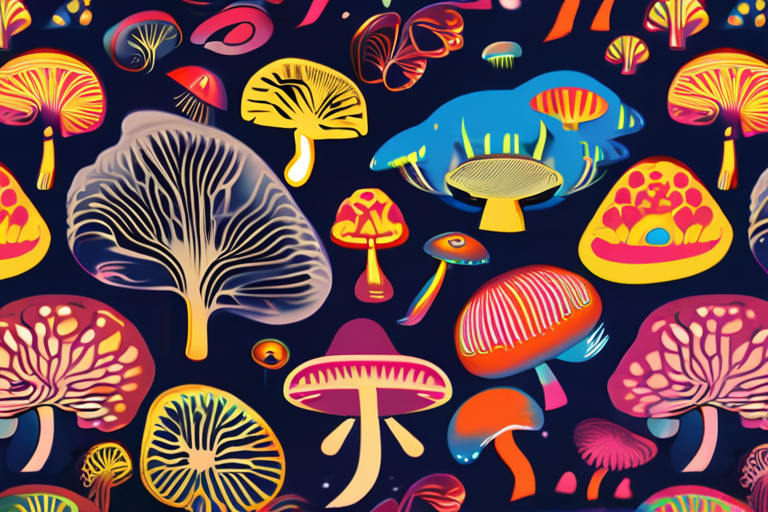Scientists Stunned by Discovery of Magic Mushrooms' Unique Evolutionary Path
BERLIN, GERMANY - In a groundbreaking study published last month in the journal Angewandte Chemie International Edition, researchers from Germany and Austria revealed that magic mushrooms have evolved to produce psilocybin, a psychedelic compound, at least twice independently. The findings suggest that this phenomenon may be an example of convergent evolution, where unrelated forms of life develop similar traits or features.
According to the study, two distinct types of magic mushrooms, one from the genus Psilocybe and another from the genus Inocybe, produce psilocybin through entirely different biochemical pathways. This discovery has left scientists stunned, as it challenges their understanding of how these compounds evolved in nature.
"We were amazed by the diversity of biochemical routes that led to the production of psilocybin," said Dr. Maria Rodriguez, lead author of the study and a researcher at the University of Munich. "It's clear that these mushrooms have developed unique strategies to produce this compound, which is essential for their survival."
The researchers examined two species from the genus Inocybe, which are known for their ability to produce psilocybin. They found that while both species produced the same compound, they relied on distinct biochemical pathways to do so.
"This study highlights the complexity and diversity of fungal evolution," said Dr. John Taylor, a mycologist at the University of California, Berkeley. "It's a reminder that there is still much to learn about the natural world and how organisms adapt to their environments."
The discovery has significant implications for our understanding of convergent evolution, which suggests that unrelated species can develop similar traits or features in response to similar environmental pressures.
"Convergent evolution is a fundamental concept in biology, but it's not well understood," said Dr. Rodriguez. "This study provides new insights into how this process occurs and highlights the importance of studying fungal evolution."
The researchers plan to continue their studies on the biochemical pathways that lead to psilocybin production in magic mushrooms.
"This research has far-reaching implications for our understanding of the natural world and could potentially lead to new discoveries in fields such as medicine and agriculture," said Dr. Taylor.
As scientists continue to unravel the mysteries of fungal evolution, this discovery serves as a reminder of the awe-inspiring complexity and diversity of life on Earth.
In related news, researchers from around the world are taking notice of the study's findings and are eager to contribute their expertise to further understanding the evolution of psilocybin-producing mushrooms. The scientific community is abuzz with excitement, and it remains to be seen what new discoveries will emerge from this groundbreaking research.
Background:
Magic mushrooms have been used for centuries in traditional medicine and spiritual practices around the world. Psilocybin, a key component of these mushrooms, has been shown to have therapeutic properties and is being studied as a potential treatment for mental health disorders such as depression and anxiety.
The study's findings have significant implications for our understanding of convergent evolution and the natural world. As scientists continue to explore the complexities of fungal evolution, they may uncover new insights into the mechanisms that govern life on Earth.
Additional perspectives:
Dr. Taylor notes that this discovery highlights the importance of interdisciplinary research in biology. "This study demonstrates the power of collaboration between researchers from different fields," he said. "It's a testament to the value of international cooperation and the exchange of ideas."
The study's findings have also sparked interest among mycologists, who are eager to learn more about the biochemical pathways that lead to psilocybin production in magic mushrooms.
"This research has opened up new avenues for investigation into fungal evolution," said Dr. Rodriguez. "We're excited to continue our studies and uncover the secrets of these fascinating organisms."
Current status:
The study's findings have been published in the journal Angewandte Chemie International Edition, and researchers from around the world are eagerly awaiting further developments.
Next developments:
Researchers plan to continue their studies on the biochemical pathways that lead to psilocybin production in magic mushrooms. They hope to uncover new insights into the mechanisms of convergent evolution and shed light on the complexities of fungal evolution.
Sources:
Dr. Maria Rodriguez, University of Munich
Dr. John Taylor, University of California, Berkeley
Angewandte Chemie International Edition (journal)
*Reporting by Gizmodo.*



 Hoppi
Hoppi

 Hoppi
Hoppi

 Hoppi
Hoppi

 Hoppi
Hoppi

 Hoppi
Hoppi

 Hoppi
Hoppi











